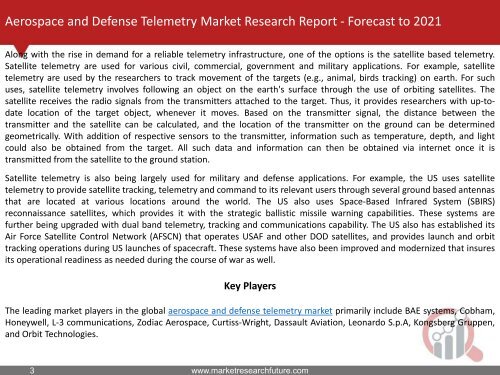Aerospace and Defense Telemetry Market
Global Aerospace and Defense Telemetry Market Report by Equipment (Data Acquisition Unit, Telemetry Transmitters, Flight Termination Receivers, and Other Equipment), by Application (Aircraft, Spacecraft, UAVs, and Others), and by Region – Forecast to 2023
Global Aerospace and Defense Telemetry Market Report by Equipment (Data Acquisition Unit, Telemetry Transmitters, Flight Termination Receivers, and Other Equipment), by Application (Aircraft, Spacecraft, UAVs, and Others), and by Region – Forecast to 2023
Create successful ePaper yourself
Turn your PDF publications into a flip-book with our unique Google optimized e-Paper software.
3<br />
www.marketresearchfuture.com<br />
<strong>Aerospace</strong> <strong>and</strong> <strong>Defense</strong> <strong>Telemetry</strong> <strong>Market</strong> Research Report - Forecast to 2021<br />
Along with the rise in dem<strong>and</strong> for a reliable telemetry infrastructure, one of the options is the satellite based telemetry.<br />
Satellite telemetry are used for various civil, commercial, government <strong>and</strong> military applications. For example, satellite<br />
telemetry are used by the researchers to track movement of the targets (e.g., animal, birds tracking) on earth. For such<br />
uses, satellite telemetry involves following an object on the earth's surface through the use of orbiting satellites. The<br />
satellite receives the radio signals from the transmitters attached to the target. Thus, it provides researchers with up-todate<br />
location of the target object, whenever it moves. Based on the transmitter signal, the distance between the<br />
transmitter <strong>and</strong> the satellite can be calculated, <strong>and</strong> the location of the transmitter on the ground can be determined<br />
geometrically. With addition of respective sensors to the transmitter, information such as temperature, depth, <strong>and</strong> light<br />
could also be obtained from the target. All such data <strong>and</strong> information can then be obtained via internet once it is<br />
transmitted from the satellite to the ground station.<br />
Satellite telemetry is also being largely used for military <strong>and</strong> defense applications. For example, the US uses satellite<br />
telemetry to provide satellite tracking, telemetry <strong>and</strong> comm<strong>and</strong> to its relevant users through several ground based antennas<br />
that are located at various locations around the world. The US also uses Space-Based Infrared System (SBIRS)<br />
reconnaissance satellites, which provides it with the strategic ballistic missile warning capabilities. These systems are<br />
further being upgraded with dual b<strong>and</strong> telemetry, tracking <strong>and</strong> communications capability. The US also has established its<br />
Air Force Satellite Control Network (AFSCN) that operates USAF <strong>and</strong> other DOD satellites, <strong>and</strong> provides launch <strong>and</strong> orbit<br />
tracking operations during US launches of spacecraft. These systems have also been improved <strong>and</strong> modernized that insures<br />
its operational readiness as needed during the course of war as well.<br />
Key Players<br />
The leading market players in the global aerospace <strong>and</strong> defense telemetry market primarily include BAE systems, Cobham,<br />
Honeywell, L-3 communications, Zodiac <strong>Aerospace</strong>, Curtiss-Wright, Dassault Aviation, Leonardo S.p.A, Kongsberg Gruppen,<br />
<strong>and</strong> Orbit Technologies.


















